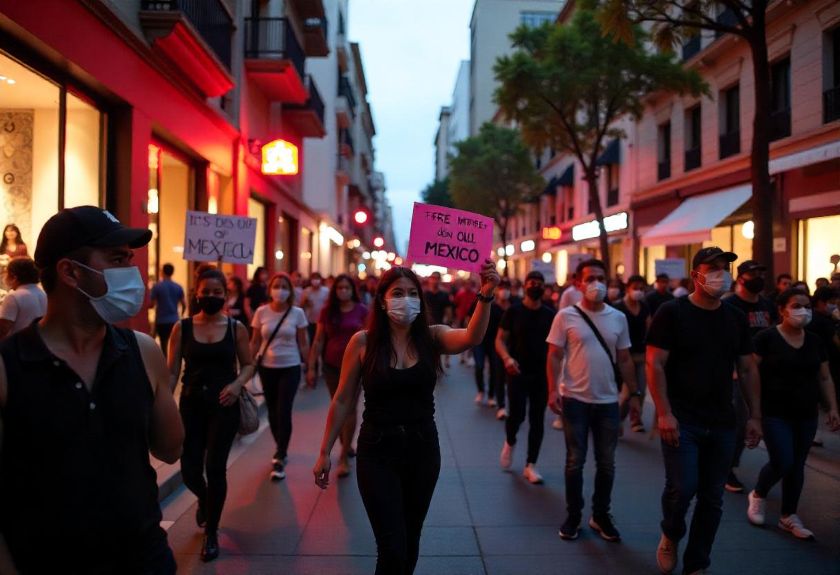Sunday, July 6, 2025
A protest to denounce gentrification and mass tourism that began peacefully in Mexico City on Friday took a violent turn when some individuals began shattering storefronts and threatening tourists. The demonstration, initially summoned to address issues related to gentrification, saw masked protesters racing through high-end shops in the trendy Condesa and Roma neighborhoods. Those neighborhoods, with restaurants, cafes, and nightlife, have become popular among foreign tourists in particular from the United States.
Shouting at the tourists, the demonstrators then went ahead and smashed storefronts, shattering glass and looting shops. As the protestors marched in the direction of the U.S. Embassy, graffiti “Get out of Mexico” was sprayed onto windows and buildings to suggest the growing vexation with the tourism boom. Stones were thrown, again increasing the tension. Police reinforcements were dispatched to the embassy, sirens echoing through the city center.
While the protest had started as a peaceful march in the morning hours, its atmosphere quickly shifted when frustration with higher rents and increasing numbers of American tourists was front and center. Mexico City has seen a steep rise in foreign travelers in recent years, particularly since 2020 when initial waves ofdigital nomadscame to Mexico to flee pandemic lockdowns in the U.S. Rents have risen precipitously as a result and have driven out long-time residents in neighborhoods like Condesa and Roma.
This tourism boom has also brought with it gentrification which has rendered long-time residents strangers in their own neighborhoods by economically excluding them from residing in their own culturally thriving neighborhoods.
Broader Background: Protests Over Mass Tourism Throughout Europe
The Mexico City protests come at a time when in the rest of the world there are tourist centers grappling with criticism of mass tourism as well. Barcelona, Madrid, Paris, and Rome have had similar protests in the last few years when citizens have had concerns about how tourism has damaged their communities and their infrastructures.
Europe in the last year had a record 747 million foreign visitors, the highest number to any region in the globe, according to the U.N. World Tourism Barometer. A great deal of this is attributed to cheaper means of travel, tourism patterns shaped through the use of social media platforms, and how trips can easily now be organized through the use of electronic media. Destinations such as Venice and Barcelona have had throngs of tourists largely from the U.S., Japan, China, and the U.K.
Critics argue that these large numbers of tourists strain area housing stock, facilities, and water supplies and have led to various city uprisings in which the residents have expressed their concerns with overtourism. These uprisings have often revolved around the effects that tourism has in damaging the local communities, from residents being pushed out due to accelerating rents to the damage to the environment that stems from crowded hotspots.
Growing Global Opposition to Overtourism
These Mexican City protests are not an isolated incident; they are part of a trend in which individuals in major tourist locations are objecting to effects coming from mass tourism. The rapid growth within the tourism industry due to more affordable travel being an option, more power coming from media platforms such as Facebook and Twitter, and good economic fortunes in most affluent nations has led to increased frustration within the individuals residing in said locations and feeling them directly in their everyday life.
Consequently, some cities have begun to implement measures to counterbalance the impacts of overtourism. From limiting the number of tourists at the most popular tourist spots to encouraging sustainable trends in tourism, city administrations and civil society advocates are calling for more sustainable and responsible mechanisms in administering tourism while still keeping in mind the interests of the people and the positive contribution of tourism.
As the debate continues to rage, time alone will reveal how Mexico City and its international counterparts will walk the thin line between welcoming tourists and ensuring their citizens’ quality of life remains intact. What is for sure is that the international debate in regard to gentrification and mass tourism continues to mount and opposition will continue to thrive as neighborhoods struggle to regain their territory from the crushing forces of tourism.
«Enjoyed this post? Never miss out on future posts by following us»
